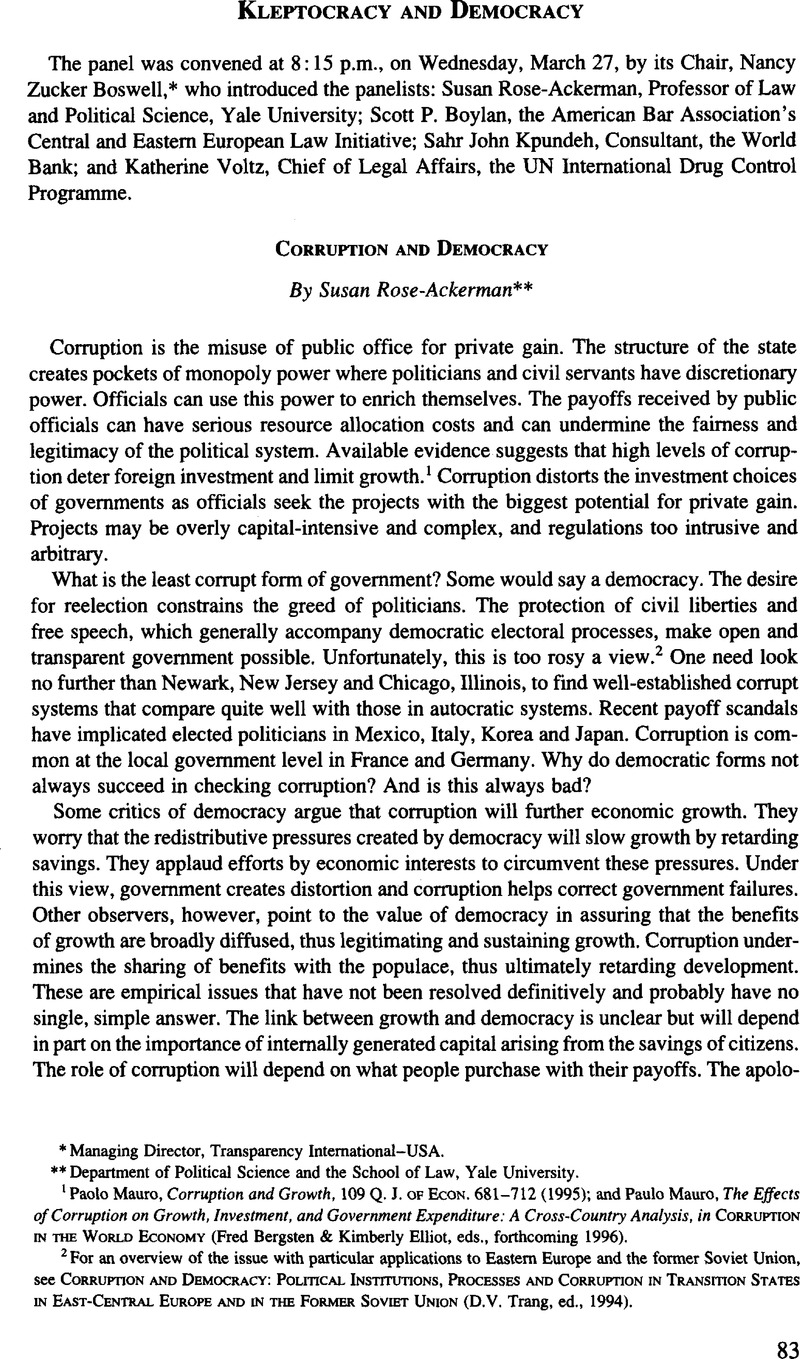Article contents
Corruption and Democracy
Published online by Cambridge University Press: 17 February 2017
Abstract

- Type
- Kleptocracy and Democracy
- Information
- Copyright
- Copyright © American Society of International Law 2015
References
* Managing Director, Transparency International-USA.
1 Paolo Mauro, Corruption and Growth, 109 Q. J. of Econ. 681–712 (1995); and Paulo Mauro, The Effects of Corruption on Growth, Investment, and Government Expenditure: A Cross-Country Analysis, in Corruption in the World Economy (Fred Bergsten & Kimberly Elliot, eds., forthcoming 1996).
2 For an overview of the issue with particular applications to Eastern Europe and the former Soviet Union, see Corruption and Democracy: Political Institutions, Processes and Corruption in Transition States in East-Central Europe and in the Former Soviet Union (D.V. Trang, ed., 1994).
3 For a fuller discussion of the costs of corruption see Susan Rose-Ackerman, Corruption: A Study in Political Economy (1978), and Susan Rose-Ackerman, The Political Economy of Corruption, in Corruption in the World Economy (Fred Bergsten & Kimberly Elliot, eds., forthcoming 1996).
4 Compare Mancur Olson, Dictatorship, Democracy, and Development, 87 Am. Pol. Sci. Rev. 567–575 (1993); and Mancur Olson, The Rise and Decline of Nations (1982).
5 See the discussion of the Nigerian case in Larry Diamond, Nigeria's Perennial Struggle Against Corruption: Prospects for the Third Republic, 7 Corruption and Reform 215–25 (1993).
6 Indonesia may be an example of this case. See Ozay Mehmet, Rent-Seeking and Gate-Keeping in Indonesia: A Cultural and Economic Analysis, 27 Labour, Capital and Society 56–89 (1994).
7 Edoardo Campos and Hilton Root, East Asia's Road to High Growth: An Institutional Perspective (1996). The authors argue that Indonesia is at such a critical and risky point.
8 Susan Rose-Ackerman, Corruption: A Study in Political Economy (1978).
9 Park, B.S. Corruption in Non-Western Democracies: The Case of South-Korea Party Politics (1995) (draft on file with Kim Dae-Jung Peace Foundation); and Pasuk Phonopaicht and Sunosidh Piriyaranosan, Corruption and Democracy in Thailand (1994)Google Scholar.
10 Susan Rose-Ackerman, Corruption: A Study in Political Economy (1978).
11 Eric, Rasmusen Mark, Ramseyer Cheap Bribes and the Corruption Ban: A Coordination Game Among Rational Legislators, 78 Pub. Choice 305 327 (1994)Google Scholar.
12 For a guide to reform strategies see National Integrity Systems: The TI Source Book (Jeremy Pope, ed., 1996).
13 David, Fleischer Attempts at Corruption Control in Brazil: Congressional Investigations and Strengthening Internal Control (delivered at the Annual Meeting of the Latin American Political Science Association, September 1995); and Luigi Manzetti and Charles Blake, Market Reform and Corruption in Latin America: New Means for Old Ways, in Rev. of Int'l Pol. Econ. (forthcoming 1996). In both pieces the authors claim that the lack of an independent judiciary is one reason why Latin American efforts to reduce corruption have often faltered.Google Scholar
14 See National Integrity Systems: The TI Source Book (Jeremy Pope, ed., 1996). The model often used is the Hong Kong Independent Commission against Corruption that has been recently imitated by Botswana.
15 Many recent African cases are discussed in George B.N. Ayittey, Africa Betrayed (1992).
16 For a fuller discussion see Susan Rose-Ackerman, Corruption: A Study in Political Economy (1978).
- 7
- Cited by




